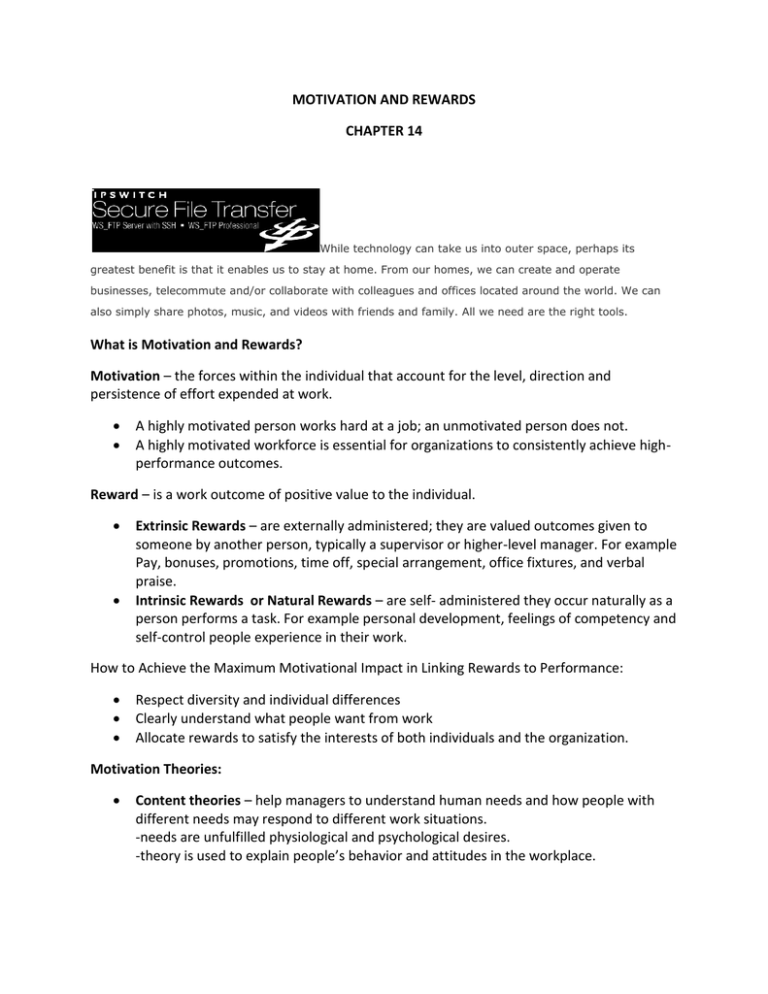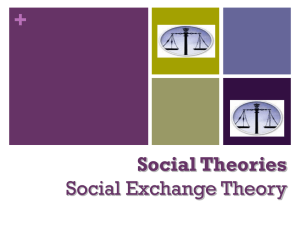MOTIVATION AND REWARDS CHAPTER 14
advertisement

MOTIVATION AND REWARDS CHAPTER 14 While technology can take us into outer space, perhaps its greatest benefit is that it enables us to stay at home. From our homes, we can create and operate businesses, telecommute and/or collaborate with colleagues and offices located around the world. We can also simply share photos, music, and videos with friends and family. All we need are the right tools. What is Motivation and Rewards? Motivation – the forces within the individual that account for the level, direction and persistence of effort expended at work. A highly motivated person works hard at a job; an unmotivated person does not. A highly motivated workforce is essential for organizations to consistently achieve highperformance outcomes. Reward – is a work outcome of positive value to the individual. Extrinsic Rewards – are externally administered; they are valued outcomes given to someone by another person, typically a supervisor or higher-level manager. For example Pay, bonuses, promotions, time off, special arrangement, office fixtures, and verbal praise. Intrinsic Rewards or Natural Rewards – are self- administered they occur naturally as a person performs a task. For example personal development, feelings of competency and self-control people experience in their work. How to Achieve the Maximum Motivational Impact in Linking Rewards to Performance: Respect diversity and individual differences Clearly understand what people want from work Allocate rewards to satisfy the interests of both individuals and the organization. Motivation Theories: Content theories – help managers to understand human needs and how people with different needs may respond to different work situations. -needs are unfulfilled physiological and psychological desires. -theory is used to explain people’s behavior and attitudes in the workplace. Process theories – help managers to understand how people give meaning to rewards and then respond with various work-related behaviors. Reinforcement theory – helps managers understand the environment as a major source of rewards and how people’s behavior is influenced by these consequences. Clayton Alderfer’s ERG theory is an extension of Maslow’s theory. Instead of five need levels, Alderfer proposed three need levels, the first letters of which are identified by the name of the theory itself––ERG. a. Existence needs are desires for physiological and material well being. b. Relatedness needs are desires for satisfying interpersonal relationships. c. Growth needs are desires for continued psychological growth and development. Two-factor theory: Hygiene factors are elements of the job context that serve as sources of job dissatisfaction. Types of hygiene factors. (1) Working conditions. (2) Interpersonal relations. (3) Organizational policies and administration. (4) Technical quality of supervision. (5) Base wage or salary. Improvements in hygiene factors can prevent and/or eliminate job dissatisfaction; they will not improve job satisfaction. Satisfier factors are elements of the job content that serve as sources of job satisfaction. Types of satisfier factors. (1) Sense of achievement. (2) Feelings of recognition. (3) Sense of responsibility. (4) Opportunity for advancement. (5) Feelings of personal growth. Acquired-needs theory. 1. David McClelland proposes that people acquire needs through their life experiences. a. Need for achievement. The desire to do something better or more efficiently, to solve problems, or to master complex tasks. b. Need for power. The desire to control other persons, to influence their behavior, or to be responsible for other people. c. Need for affiliation. The desire to establish and maintain friendly and warm relations with other persons Process theories of motivation -focus on how people actually make choices to work hard or not, based on their individual preferences, the available rewards, and possible work outcomes. The process theories are: Equity theory asserts that when people believe that they have been treated unfairly in comparison to others, they try to eliminate the discomfort and restore a perceived sense of equity to the situation. People who feel underpaid experience a sense of anger. People who feel overpaid experience a sense of guilt. Expectancy theory: people will do what they can do when they want to do it. Goal-setting theory - When goals must be assigned, workers will respond more positively if supervisors are trusted and the workers believe they will be adequately supported in their efforts to achieve the goals. Punishment. To punish an employee, a manager may deny the person a valued reward (such as verbal praise or pay) or the manager may administer an unpleasant outcome (such as a verbal reprimand, pay reduction, or demotion). Tell the person what is being done wrong. Tell the person what is being done right. Make sure the punishment matches the behavior. Administer the punishment in private. Pay for performance. Paying people for their performance is consistent with equity, expectancy, and reinforcement theories. Merit pay is a compensation system that awards pay increases in proportion to individual performance contributions. Incentive compensation systems. a. Skills-based pay links pay to the number of job-relevant skills an employee masters. b. Skills-based pay is common in self-managing teams where part of the “self-management” includes responsibilities for the training and certification of coworkers in job skills. Bonus pay plans provide one-time or lump-sum payments to employees based on the accomplishment of specific performance targets or some other extraordinary contribution. Profit-sharing plans distribute to some or all employees a proportion of net profits earned by the organization during a stated performance period.





